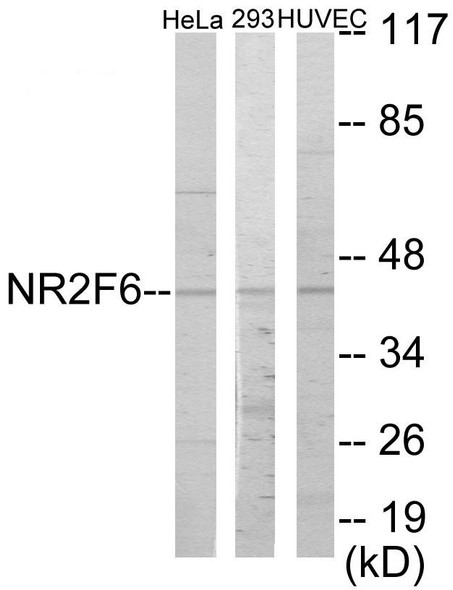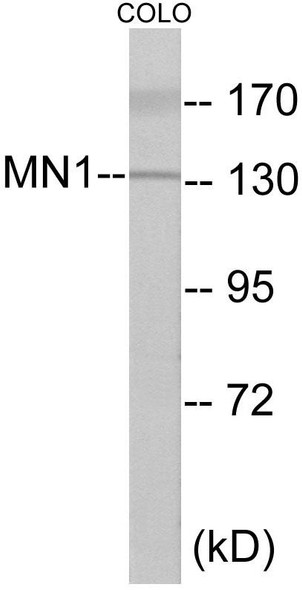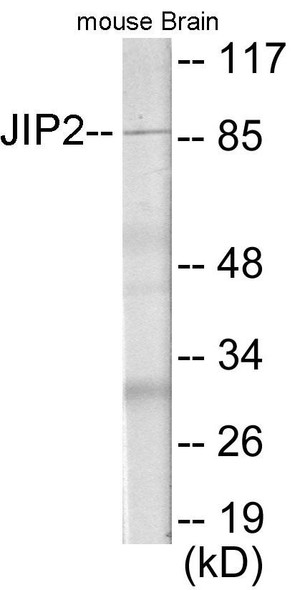Description
HORMAD1 Colorimetric Cell-Based ELISA
The HORMAD1 Colorimetric Cell-Based ELISA Kit is a powerful tool for detecting HORMAD1 levels in cell lysates and culture supernatants. This kit offers high sensitivity and specificity, allowing for precise and consistent results in a variety of research applications.HORMAD1 is a key protein involved in meiotic recombination and chromosome synapsis, playing a crucial role in ensuring genomic stability. Dysregulation of HORMAD1 has been linked to infertility and certain types of cancer, making it a valuable biomarker for studying these conditions and developing targeted therapies.
With the HORMAD1 Colorimetric Cell-Based ELISA Kit, researchers can gain valuable insights into the role of HORMAD1 in cellular processes and disease progression, ultimately aiding in the advancement of biomedical research and potential treatment strategies.
| Product Name: | HORMAD1 Colorimetric Cell-Based ELISA |
| Product Code: | CBCAB01147 |
| ELISA Type: | Cell-Based |
| Target: | HORMAD1 |
| Reactivity: | Human |
| Dynamic Range: | > 5000 Cells |
| Detection Method: | Colorimetric 450 nmStorage/Stability:4°C/6 Months |
| Format: | 96-Well Microplate |
The HORMAD1 Colorimetric Cell-Based ELISA Kit is a convenient, lysate-free, high throughput and sensitive assay kit that can detect HORMAD1 protein expression profile in cells. The kit can be used for measuring the relative amounts of HORMAD1 in cultured cells as well as screening for the effects that various treatments, inhibitors (ie siRNA or chemicals), or activators have on HORMAD1.
Qualitative determination of HORMAD1 concentration is achieved by an indirect ELISA format. In essence, HORMAD1 is captured by HORMAD1-specific primary antibodies while the HRP-conjugated secondary antibodies bind the Fc region of the primary antibody. Through this binding, the HRP enzyme conjugated to the secondary antibody can catalyze a colorimetric reaction upon substrate addition. Due to the qualitative nature of the Cell-Based ELISA, multiple normalization methods are needed:
| 1. | A monoclonal antibody specific for human GAPDH is included to serve as an internal positive control in normalizing the target absorbance values. |
| 2. | Following the colorimetric measurement of HRP activity via substrate addition, the Crystal Violet whole-cell staining method may be used to determine cell density. After staining, the results can be analysed by normalizing the absorbance values to cell amounts, by which the plating difference can be adjusted. |
| Database Information: | Gene ID: 84072, UniProt ID: Q86X24, OMIM: 609824, Unigene: Hs.298312 |
| Gene Symbol: | HORMAD1 |
| Sub Type: | None |
| UniProt Protein Function: | HORMAD1: Plays a key role in meiotic progression. Regulates 3 different functions during meiosis: ensures that sufficient numbers of processed DNA double-strand breaks (DSBs) are available for successful homology search by increasing the steady-state numbers of single-stranded DSB ends. Promotes synaptonemal-complex formation independently of its role in homology search. Plays a key role in the male mid-pachytene checkpoint and the female meiotic prophase checkpoint: required for efficient build-up of ATR activity on unsynapsed chromosome regions, a process believed to form the basis of meiotic silencing of unsynapsed chromatin (MSUC) and meiotic prophase quality control in both sexes. 5 isoforms of the human protein are produced by alternative splicing. |
| UniProt Protein Details: | Protein type:Cancer Testis Antigen (CTA) Chromosomal Location of Human Ortholog: 1q21.3 Cellular Component: chromosome; nucleus Biological Process: blastocyst development; meiosis; meiotic DNA double-strand break formation; meiotic recombination checkpoint; meiotic sister chromatid cohesion; oogenesis; spermatogenesis; synaptonemal complex assembly |
| NCBI Summary: | This gene encodes a HORMA domain-containing protein. HORMA domains are involved in chromatin binding and play a role in cell cycle regulation. The encoded protein may play a role in meiosis, and expression of this gene is a potential marker for cancer. A pseudogene of this gene is located on the long arm of chromosome 6. Alternatively spliced transcript variants encoding multiple isoforms have been observed for this gene. [provided by RefSeq, Dec 2010] |
| UniProt Code: | Q86X24 |
| NCBI GenInfo Identifier: | 74750516 |
| NCBI Gene ID: | 84072 |
| NCBI Accession: | Q86X24.1 |
| UniProt Secondary Accession: | Q86X24,Q4G114, Q5T5I3, Q5T5I4, Q5T5I5, Q6FIC1, Q9H0K8 A6NMK2, B3KUK1, |
| UniProt Related Accession: | Q86X24 |
| Molecular Weight: | 36,676 Da |
| NCBI Full Name: | HORMA domain-containing protein 1 |
| NCBI Synonym Full Names: | HORMA domain containing 1 |
| NCBI Official Symbol: | HORMAD1 |
| NCBI Official Synonym Symbols: | CT46; NOHMA |
| NCBI Protein Information: | HORMA domain-containing protein 1 |
| UniProt Protein Name: | HORMA domain-containing protein 1 |
| UniProt Synonym Protein Names: | Cancer/testis antigen 46; CT46; Newborn ovary HORMA protein |
| Protein Family: | HORMA domain-containing protein |
| UniProt Gene Name: | HORMAD1 |
| UniProt Entry Name: | HORM1_HUMAN |
| Component | Quantity |
| 96-Well Cell Culture Clear-Bottom Microplate | 2 plates |
| 10X TBS | 24 mL |
| Quenching Buffer | 24 mL |
| Blocking Buffer | 50 mL |
| 15X Wash Buffer | 50 mL |
| Primary Antibody Diluent | 12 mL |
| 100x Anti-Phospho Target Antibody | 60 µL |
| 100x Anti-Target Antibody | 60 µL |
| Anti-GAPDH Antibody | 60 µL |
| HRP-Conjugated Anti-Rabbit IgG Antibody | 12 mL |
| HRP-Conjugated Anti-Mouse IgG Antibody | 12 mL |
| SDS Solution | 12 mL |
| Stop Solution | 24 mL |
| Ready-to-Use Substrate | 12 mL |
| Crystal Violet Solution | 12 mL |
| Adhesive Plate Seals | 2 seals |
The following materials and/or equipment are NOT provided in this kit but are necessary to successfully conduct the experiment:
- Microplate reader able to measure absorbance at 450 nm and/or 595 nm for Crystal Violet Cell Staining (Optional)
- Micropipettes with capability of measuring volumes ranging from 1 µL to 1 ml
- 37% formaldehyde (Sigma Cat# F-8775) or formaldehyde from other sources
- Squirt bottle, manifold dispenser, multichannel pipette reservoir or automated microplate washer
- Graph paper or computer software capable of generating or displaying logarithmic functions
- Absorbent papers or vacuum aspirator
- Test tubes or microfuge tubes capable of storing ≥1 ml
- Poly-L-Lysine (Sigma Cat# P4832 for suspension cells)
- Orbital shaker (optional)
- Deionized or sterile water
*Note: Protocols are specific to each batch/lot. For the correct instructions please follow the protocol included in your kit.
| Step | Procedure |
| 1. | Seed 200 µL of 20,000 adherent cells in culture medium in each well of a 96-well plate. The plates included in the kit are sterile and treated for cell culture. For suspension cells and loosely attached cells, coat the plates with 100 µL of 10 µg/ml Poly-L-Lysine (not included) to each well of a 96-well plate for 30 minutes at 37°C prior to adding cells. |
| 2. | Incubate the cells for overnight at 37°C, 5% CO2. |
| 3. | Treat the cells as desired. |
| 4. | Remove the cell culture medium and rinse with 200 µL of 1x TBS, twice. |
| 5. | Fix the cells by incubating with 100 µL of Fixing Solution for 20 minutes at room temperature. The 4% formaldehyde is used for adherent cells and 8% formaldehyde is used for suspension cells and loosely attached cells. |
| 6. | Remove the Fixing Solution and wash the plate 3 times with 200 µL 1x Wash Buffer for five minutes each time with gentle shaking on the orbital shaker. The plate can be stored at 4°C for a week. |
| 7. | Add 100 µL of Quenching Buffer and incubate for 20 minutes at room temperature. |
| 8. | Wash the plate 3 times with 1x Wash Buffer for 5 minutes each time. |
| 9. | Add 200 µL of Blocking Buffer and incubate for 1 hour at room temperature. |
| 10. | Wash 3 times with 200 µL of 1x Wash Buffer for 5 minutes each time. |
| 11. | Add 50 µL of 1x primary antibodies (Anti-HORMAD1 Antibody and/or Anti-GAPDH Antibody) to the corresponding wells, cover with Parafilm and incubate for 16 hours (overnight) at 4°C. If the target expression is known to be high, incubate for 2 hours at room temperature. |
| 12. | Wash 3 times with 200 µL of 1x Wash Buffer for 5 minutes each time. |
| 13. | Add 50 µL of 1x secondary antibodies (HRP-Conjugated AntiRabbit IgG Antibody or HRP-Conjugated Anti-Mouse IgG Antibody) to corresponding wells and incubate for 1.5 hours at room temperature. |
| 14. | Wash 3 times with 200 µL of 1x Wash Buffer for 5 minutes each time. |
| 15. | Add 50 µL of Ready-to-Use Substrate to each well and incubate for 30 minutes at room temperature in the dark. |
| 16. | Add 50 µL of Stop Solution to each well and read OD at 450 nm immediately using the microplate reader. |
(Additional Crystal Violet staining may be performed if desired – details of this may be found in the kit technical manual.)






